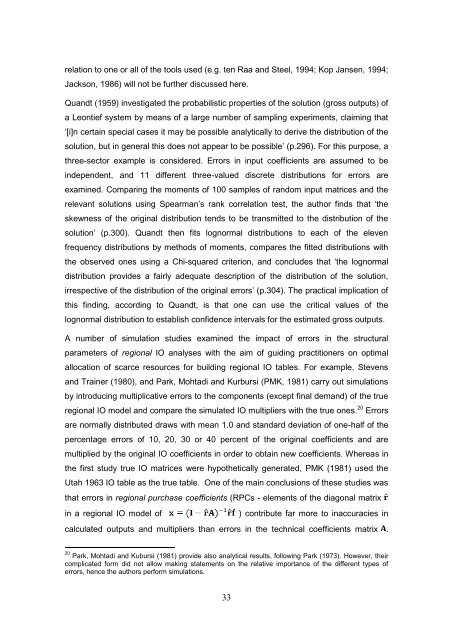Uncertainty treatment in input-output analysis
ifDakU
ifDakU
Create successful ePaper yourself
Turn your PDF publications into a flip-book with our unique Google optimized e-Paper software.
elation to one or all of the tools used (e.g. ten Raa and Steel, 1994; Kop Jansen, 1994;<br />
Jackson, 1986) will not be further discussed here.<br />
Quandt (1959) <strong>in</strong>vestigated the probabilistic properties of the solution (gross <strong>output</strong>s) of<br />
a Leontief system by means of a large number of sampl<strong>in</strong>g experiments, claim<strong>in</strong>g that<br />
„[i]n certa<strong>in</strong> special cases it may be possible analytically to derive the distribution of the<br />
solution, but <strong>in</strong> general this does not appear to be possible‟ (p.296). For this purpose, a<br />
three-sector example is considered. Errors <strong>in</strong> <strong>in</strong>put coefficients are assumed to be<br />
<strong>in</strong>dependent, and 11 different three-valued discrete distributions for errors are<br />
exam<strong>in</strong>ed. Compar<strong>in</strong>g the moments of 100 samples of random <strong>in</strong>put matrices and the<br />
relevant solutions us<strong>in</strong>g Spearman‟s rank correlation test, the author f<strong>in</strong>ds that „the<br />
skewness of the orig<strong>in</strong>al distribution tends to be transmitted to the distribution of the<br />
solution‟ (p.300). Quandt then fits lognormal distributions to each of the eleven<br />
frequency distributions by methods of moments, compares the fitted distributions with<br />
the observed ones us<strong>in</strong>g a Chi-squared criterion, and concludes that „the lognormal<br />
distribution provides a fairly adequate description of the distribution of the solution,<br />
irrespective of the distribution of the orig<strong>in</strong>al errors‟ (p.304). The practical implication of<br />
this f<strong>in</strong>d<strong>in</strong>g, accord<strong>in</strong>g to Quandt, is that one can use the critical values of the<br />
lognormal distribution to establish confidence <strong>in</strong>tervals for the estimated gross <strong>output</strong>s.<br />
A number of simulation studies exam<strong>in</strong>ed the impact of errors <strong>in</strong> the structural<br />
parameters of regional IO analyses with the aim of guid<strong>in</strong>g practitioners on optimal<br />
allocation of scarce resources for build<strong>in</strong>g regional IO tables. For example, Stevens<br />
and Tra<strong>in</strong>er (1980), and Park, Mohtadi and Kurbursi (PMK, 1981) carry out simulations<br />
by <strong>in</strong>troduc<strong>in</strong>g multiplicative errors to the components (except f<strong>in</strong>al demand) of the true<br />
regional IO model and compare the simulated IO multipliers with the true ones. 20 Errors<br />
are normally distributed draws with mean 1.0 and standard deviation of one-half of the<br />
percentage errors of 10, 20, 30 or 40 percent of the orig<strong>in</strong>al coefficients and are<br />
multiplied by the orig<strong>in</strong>al IO coefficients <strong>in</strong> order to obta<strong>in</strong> new coefficients. Whereas <strong>in</strong><br />
the first study true IO matrices were hypothetically generated, PMK (1981) used the<br />
Utah 1963 IO table as the true table. One of the ma<strong>in</strong> conclusions of these studies was<br />
that errors <strong>in</strong> regional purchase coefficients (RPCs - elements of the diagonal matrix<br />
<strong>in</strong> a regional IO model of<br />
) contribute far more to <strong>in</strong>accuracies <strong>in</strong><br />
calculated <strong>output</strong>s and multipliers than errors <strong>in</strong> the technical coefficients matrix .<br />
20 Park, Mohtadi and Kubursi (1981) provide also analytical results, follow<strong>in</strong>g Park (1973). However, their<br />
complicated form did not allow mak<strong>in</strong>g statements on the relative importance of the different types of<br />
errors, hence the authors perform simulations.<br />
33


